Introduction
Understanding the complexities of autism spectrum disorder (ASD) is essential for those invested in the well-being of affected children. Early detection and accurate diagnosis play a crucial role in altering the life trajectory of individuals with autism, as only a fraction can navigate adulthood without significant support. The fabric of ASD is shaped by genetic predispositions and environmental influences, with research revealing its dynamic nature.
Technology, such as eye-tracking and machine learning models, offers hope for more precise diagnoses. ASD diagnosis is a multifaceted process, focusing not just on observable behavior but also on developmental and communicative nuances. The diagnostic journey involves discussions with healthcare professionals, utilizing standardized tools like the Autism Diagnostic Observation Schedule (ADOS-2) and the Autism Diagnostic Interview-Revised (ADI-R).
Other assessment tools, such as SenseToKnow, offer innovative approaches. Direct observation, interviews with caregivers, and assessing co-occurring conditions are vital elements of the evaluation process. Hearing and vision screenings are also critical, as impairments in these senses can significantly affect communication and behavior.
Interpreting the results and developing a treatment plan tailored to the individual's needs are essential steps following an autism diagnosis. The goal is to provide early intervention and the best possible outcomes for children on the spectrum. By understanding the nuances of autism diagnosis and employing a comprehensive approach, we can support children and their families on their unique journey.
Importance of Early and Accurate Diagnosis
Comprehending the intricacies of ASD is crucial for those invested in the well-being of impacted youngsters. ASD manifests through challenges in social interaction, communication, and certain behavioral patterns. Significantly, early detection is crucial in changing the life trajectory of individuals with the condition. Only a small fraction, between 10-20%, of children diagnosed before the age of 5 can navigate adulthood without significant support.
The fabric of ASD is complex, interwoven with genetic predispositions and environmental influences which shape its progression and severity. Research spearheaded by experts like Dr. Robert Naviaux reveals that autism development is not static but a dynamic interplay of these factors. In the field of metabolic biomarkers, innovative research is uncovering new insights into ASD and other developmental conditions, offering optimism for more accurate assessments and interventions.
A critical aspect of ASD diagnosis is its heterogeneity; no two individuals present identically. Identifying signs, such as a lack of eye contact, not responding to one's name by 9 months, or reduced use of gestures like waving by age one, is vital. Current diagnostic practices hinge on the discerning eye of clinical professionals, yet this method, while effective, can lead to delays in intervention. With the brain's plasticity at its peak in infancy, time is of the essence to mitigate long-term disability.
In the quest for efficiency and accuracy, technology emerges as a beacon of hope. For example, eye-tracking technology offers unbiased insights into autism spectrum disorder in young children, while machine learning models like 'AutMedAI' demonstrate an impressive 80% accuracy rate in identifying autism in children below the age of two. These advancements, based on information from extensive databases like SPARK, utilize patterns within 28 factors to forecast developmental condition, reshaping the understanding of initial identification.
The importance of a timely diagnosis for individuals with this condition cannot be overstated. It serves as a gateway to early intervention, which holds the promise of optimal outcomes. Therefore, the pursuit of improved assessment technologies and a deeper understanding of the underlying biological mechanisms of autism continues to be pivotal in supporting youngsters and their families on this journey.
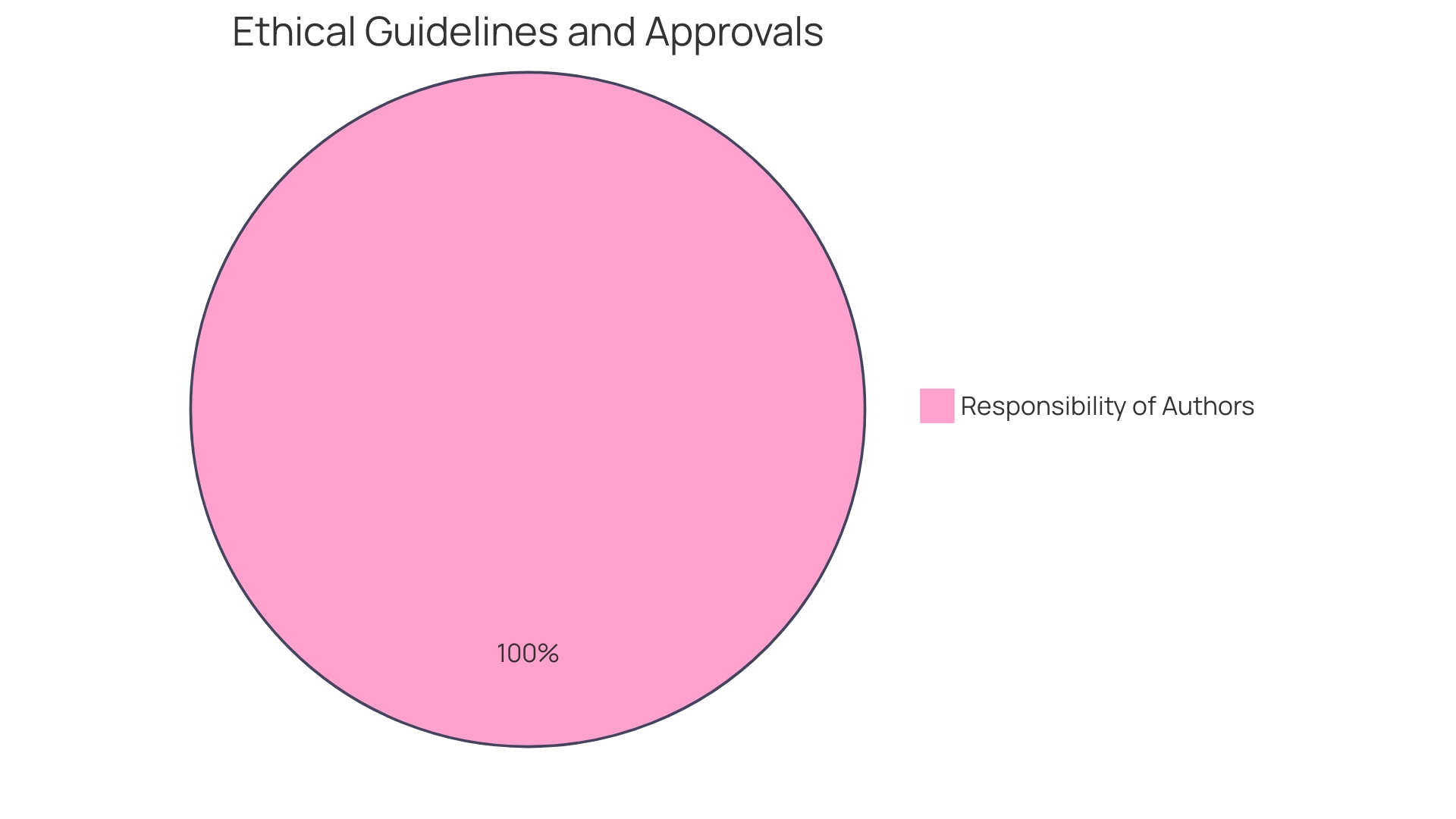
Comprehensive Evaluation Process
The identification of autism is a complex procedure, concentrating not only on the observable behavior of the individual but also on the nuances of development and communication. The evaluation aims to capture the child's unique challenges and strengths, acknowledging the spectrum nature of a condition that affects individuals differently and to varying degrees. With a prevalence rate of 1 in 36 individuals, as estimated by the CDC, comprehending the complexities of diagnosis is essential for accessing customized resources and support.
The diagnostic journey may begin with a parent's initial concerns, often leading to discussions with a primary care physician and subsequent specialist referrals. Medical professionals utilize the DSM-5 criteria, which include persistent differences in communication and social interaction across various environments, alongside restricted and repetitive behavior patterns. However, it's important to note that the medical testing model for autism is not without its flaws, and many individuals receive inconclusive results, leading some to embrace self-diagnosis within the neurodivergent community.
In the context of societal equity, as emphasized by Dr. David (Dan) R. Offord, ensuring that individuals in their early years, including those with disabilities, have equitable opportunities for participation in life's domains is fundamental for mental health and well-being. This underscores the importance of an accurate diagnosis that can lead to meaningful support for autistic children, allowing them to engage fully in school and community life.
The broader spectrum of individuals with autism, including federal agencies, researchers, and advocates like the Interagency Autism Coordinating Committee (IACC), strives to improve coordination and communication across various entities. The IACC's dedication to partnering with the neurodiverse community and its independent recommendations echo the collective expertise of its diverse members, aiming to enhance individuals' quality of life.
Overall, the diagnostic process is a critical step in recognizing the unique experiences of autistic individuals, ensuring they receive the support needed to navigate life with confidence and the opportunity to thrive.
Standardized Assessment Tools
The process of diagnosing spectrum disorder (ASD) is complex, relying heavily on insights from both parents' observations and professional evaluations. The Diagnostic and Statistical Manual, Fifth Edition (DSM-5), offers a structured framework for identifying ASD, yet no single tool can suffice for diagnosis. A mosaic of behaviors characterizes a certain condition, requiring a comprehensive approach to capture its complexity and variability. A remarkable progress in this domain is the implementation of Sense to know, a groundbreaking screening app that utilizes children's innate interactions with technology to evaluate a range of behaviors suggestive of a developmental disorder. SenseToKnow evaluates facial expressions, gaze patterns, head movements, and blink rates, alongside a playful bubble-popping game that helps in assessing motor skills, an early indicator of ASD. The application utilizes the tablet's sensors and artificial intelligence to offer a detailed assessment, potentially transforming our approach to understanding individuals with autism.
The Council of Autism Service Providers has also underscored the significance of high-quality interventions, such as Applied Behavior Analysis (ABA), highlighting the need for meticulous standards to ensure effectiveness. Additionally, the Interagency Autism Coordinating Committee (IACC) continues to enhance collaboration across federal agencies and stakeholders, fostering progress in research and services for individuals with autism spectrum disorder. Within this dynamic landscape, it is crucial to acknowledge that while technological advancements and guidelines pave the way for improved practices, the essence of autism identification remains rooted in a personalized, multifaceted approach that respects the individuality of each child on the spectrum.
Autism Diagnostic Observation Schedule (ADOS-2)
Autism Spectrum Disorder (ASD) is a complex developmental condition presenting challenges in social interaction, communication, and repetitive behaviors. Recognizing the diversity and individual uniqueness of ASD, the Autism Diagnostic Observation Schedule, Second Edition (ADOS-2), plays a pivotal role in the diagnostic process. This instrument is integral in assessing communication, social interaction, play, and imaginative use of materials for individuals suspected of having ASD.
Administered by trained clinicians, ADOS-2 involves standardized tasks prompting social exchanges and opportunities for communication. The subtleties of social interaction—such as sharing emotions, initiating or responding to social cues, and creating and maintaining reciprocal interactions—are meticulously observed. This attention to detail is crucial given that ASD manifestations vary greatly, with some individuals showing mild challenges and others having more severe symptoms affecting daily functioning.
Based on strong research, ADOS-2 enhances the accuracy of identifying ASD by encompassing a variety of behaviors characteristic of ASD. The Centers for Disease Control and Prevention (CDC) estimates ASD's prevalence as high as 1 in 36 individuals, underscoring the need for such an effective diagnostic tool. Timely and precise diagnosis is crucial, as it unlocks the opportunity for prompt intervention, which can greatly impact the person's developmental path and quality of life.
The assessment's design reflects the understanding that no single cause for Autism has been identified; rather, it is believed to result from complex brain structure or function differences. This understanding is crucial to dispel myths, such as the association of vaccines with Autism or attributions to parenting styles.
Recent developments in Autism research have highlighted the significance of timely detection and intervention. One study using a machine-learning model, 'AutMedAI,' showed approximately 80% accuracy in identifying individuals with Autism under two years old. Technology, like eye-tracking and objective screening tools, is being investigated to improve diagnostic accuracy and efficiency, especially for signs of Autism.
With the understanding that earlier therapeutic intervention can result in improved results for individuals, the ADOS-2 is more than a diagnostic assessment; it is a gateway to empowering families with early support and resources. As such, it is a cornerstone in the collective effort to understand, support, and celebrate the diversity within the Autism community.
Autism Diagnostic Interview-Revised (ADI-R)
The Autism Diagnostic Interview-Revised (ADI-R) stands as a pivotal assessment in the realm of autism diagnosis, providing a structured, interview-based approach tailored to extract nuanced information regarding an individual's social interaction and communication skills. This tool is intricately designed to capture the essence of a young person's developmental history and behavior through the perspective of those who know them bestâtheir caregivers and parents.
Using this approach, healthcare experts and researchers are prepared to explore further into the personal stories that revolve around a youngster's developmental milestones. It is a process that goes beyond mere observation, enabling a thorough exploration of the child's abilities in a naturalistic and familiar context. By doing so, the ADI-R contributes significantly to the synthesis of a reliable and valid profile necessary for an autism diagnosis, as underscored by the standards of the American Psychiatric Association's Diagnostic and Statistical Manual, Fifth Edition (DSM-5).
The profound impact of such rigorous diagnostic practices is echoed by recent advancements in the field, where the integration of machine learning models with observational protocols, such as parent-child block-play, is setting new frontiers in ASD detection. The meticulous data collection strategies employed in these studies, including those by The Center for Discovery, illuminate the possibilities of enhancing life quality for individuals with ASD and their families through early, precise intervention strategies.
In the context of the wider scientific and medical community, the ADI-R's role is a crucial part of an essential discussion on improving the identification of individuals with ASD. This ongoing dialogue aims to balance the rich, subjective experiences of individuals with ASD against the need for objective measurement—a pursuit that resonates with the collective expertise and independent recommendations of entities like the Interagency Autism Coordinating Committee (IACC).
Other Assessment Tools and Measures
While tools like ADOS-2 and ADI-R are fundamental in diagnosing individuals on the spectrum, a diverse range of assessments play a crucial role in the identification process. These tools are designed to capture a broad spectrum of characteristics related to the condition, addressing the need for comprehensive evaluations. For instance, SenseToKnow, an innovative application using tablet sensors, analyzes children's motor movements and eye-tracking responses to on-screen stimuli. Its AI-driven approach provides a nuanced understanding of signs that appear in the initial stages of developmental disorder. Furthermore, the significance of early and precise identification is highlighted by organizations such as The Autism Community in Action (TACA), which stresses the initiation of behavioral therapy as early as feasible to enhance results. Diagnostic delays not only prolong the uncertainty for families but also heighten the risk of more pronounced comorbidities. In this regard, the neurodiversity movement offers a fresh lens, advocating for environments that support autistic individuals rather than focusing on a cure. This perspective is crucial in shaping how assessments are designed and utilized, aligning with the principles of person-centered, strengths-based care.
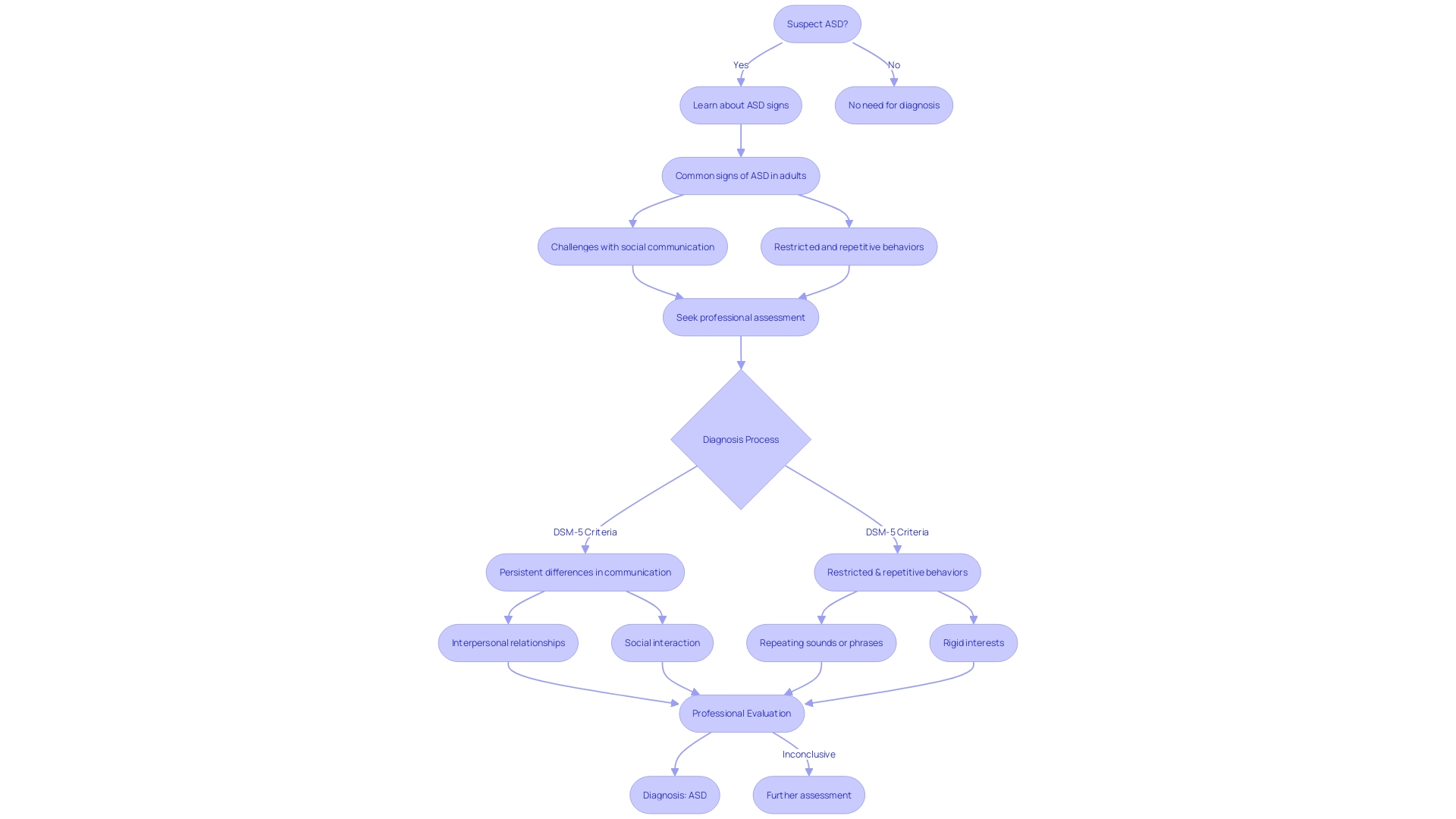
Direct Observation and Behavioral Analysis
The thorough procedure of evaluating a developmental disorder entails a meticulous combination of expert observations and an assessment of a young individual's behavior in different settings. Professionals use these observations to discern patterns and nuances in behavior that align with the Autism Spectrum Disorder (ASD) criteria outlined in the DSM-5. While parental insights provide a foundational understanding of a young person's developmental history, it is the clinician's direct observation that adds a critical dimension to the diagnosis. These observations are especially crucial given that up to 80% of young individuals and adolescents with autism spectrum disorder may exhibit aggressive behaviors, which can be complex and unpredictable due to difficulties in emotional regulation and self-reporting. With 30% to 40% of these children being minimally verbal and many lacking self-awareness, clinicians face the challenge of identifying behaviors that can obstruct access to vital services and support. By emphasizing social communication as a fundamental challenge, interventions can be effectively targeted. Joint attention, a crucial element of preverbal social communication, is often a key focus of these interventions, supporting the development of verbal skills. This systematic approach supports the pressing requirement for dependable diagnostic tools that can identify ASD as soon as feasible, a mission echoed by organizations like The Autism Community in Action (TACA) and advanced through innovative efforts by NeuroQure. Such advancements hold the potential to transform early identification, significantly improving outcomes for children with developmental challenges and offering a ray of hope for families navigating this intricate path.
Interviews with Caregivers and Family Members
Understanding the unique experiences and perspectives of parents and caregivers is essential in the autism testing process. Their insights provide a window into the individual's development and behaviors that may not be readily observable in clinical settings. 'Dr. David (Dan) R. Offord, a respected psychiatrist specialized in children, emphasized the significance of fair and supportive participation for individuals with disabilities, emphasizing that a just 'race' in life involves recognizing the strengths and challenges that each individual brings. This becomes particularly crucial for individuals with autism, who may face additional hurdles such as co-occurring emotional and behavioral problems, increasing their risk of social exclusion. The input from those who are most familiar with the individual is not only valuable but necessary to form a complete picture of their needs and to tailor interventions that foster their mental health and well-being.
Current initiatives reflect this understanding. The IACC, a federal advisory committee, works together with different stakeholders, including family members, to enhance research and services related to individuals with autism. Similarly, the Kevin and Avonte Program addresses specific challenges such as wandering, demonstrating the impactful role of community involvement and caregiver support in managing autism-related concerns. These efforts highlight the significance of caregivers' contributions to establishing nurturing environments where individuals with autism can flourish.
Assessing Co-occurring Conditions
When evaluating individuals on the spectrum of autism, it is crucial to acknowledge that autism often coexists with other conditions, which can significantly affect their daily lives. Addressing these simultaneous issues is crucial for a comprehensive understanding of every individual's distinct needs. As per the CDC, an estimated 1 in 36 individuals are impacted by the condition, emphasizing the significance of detailed and customized assessments. In this scenario, an individual with a developmental disorder may also experience attention-deficit hyperactivity disorder (ADHD), sometimes referred to on social media as 'AuDHD' or 'AutiADHD' The interplay between autism spectrum disorder and ADHD can present a complex profile, as individuals on the autistic spectrum often thrive on routine while those with ADHD seek novelty.
Additionally, scholars like Dr. Aleksandra Hollingshead emphasize the critical role of engagement in educational settings for individuals with autism spectrum disorder, advocating for strategies aligned with the Universal Design for Learning framework. Studies underscore the heightened risk of health disparities among autistic individuals, including increased mortality rates and a higher prevalence of neurological and mental health conditions. It is this intersection of co-occurring conditions and the unique health profiles of autistic individuals that necessitate a comprehensive and sensitive approach to evaluation and support.
Recent developments in technology, like the use of AI for early diagnosis of developmental disorders, showcase the progressive nature of testing, guaranteeing that young individuals receive the necessary support and resources for an equitable and encouraging 'journey,' as envisioned by Dr. David (Dan) R. Offord, a psychiatrist specializing in children's mental health. It's about establishing a fair environment where every individual, including those with a condition like autism and additional difficulties, can actively engage in all aspects of lifeâschool, home, and leisureâand where caregivers are equipped with the necessary resources to promote their child's healthy growth.
Neuropsychological Testing and Cognitive Assessments
Understanding the cognitive abilities and strengths of an individual is a critical element in the complex process of diagnosing autism spectrum disorder (ASD). Neuropsychological testing and cognitive assessments delve deep into an individual's cognitive profile, providing a comprehensive view of their capabilities.
The American Psychiatric Association's Diagnostic and Statistical Manual, Fifth Edition (DSM-5), establishes standardized criteria to diagnose ASD, and while many tools are available to assess ASD in young individuals, no single instrument should be used in isolation. These diagnostic tools usually involve information from parents or caregivers regarding the development and behavior observed by professionals.
For a nuanced evaluation, primary care providers may refer the child to specialists such as neurodevelopmental pediatricians or child neurologists, who use a variety of assessments, including the ADI-R, which focuses on social interaction, communication, and repetitive behaviors.
Innovations like the culturally competent, Autistic-led assessments provided by GRASP are making strides in the field. They provide assessments that affirm Neurodivergent individuals and can be accessed remotely, acknowledging the significance of diversity and inclusivity in diagnostic procedures.
The importance of prompt and precise identification is underscored by organizations like The Autism Community in Action (TACA), which highlight that timely intervention, such as behavioral therapy, can greatly enhance results. AI technologies, like the SenseToKnow app, are also emerging, utilizing tablet-based activities and computer vision analysis to detect early indications in toddlers.
These advancements hold promise for shortening the diagnostic journey for ASD, which can be a lengthy and stressful process, especially in families with an elevated risk. As the landscape of medicine and psychiatry evolves with AI and new diagnostic tools, the goal remains to provide timely support and intervention for those affected by ASD.
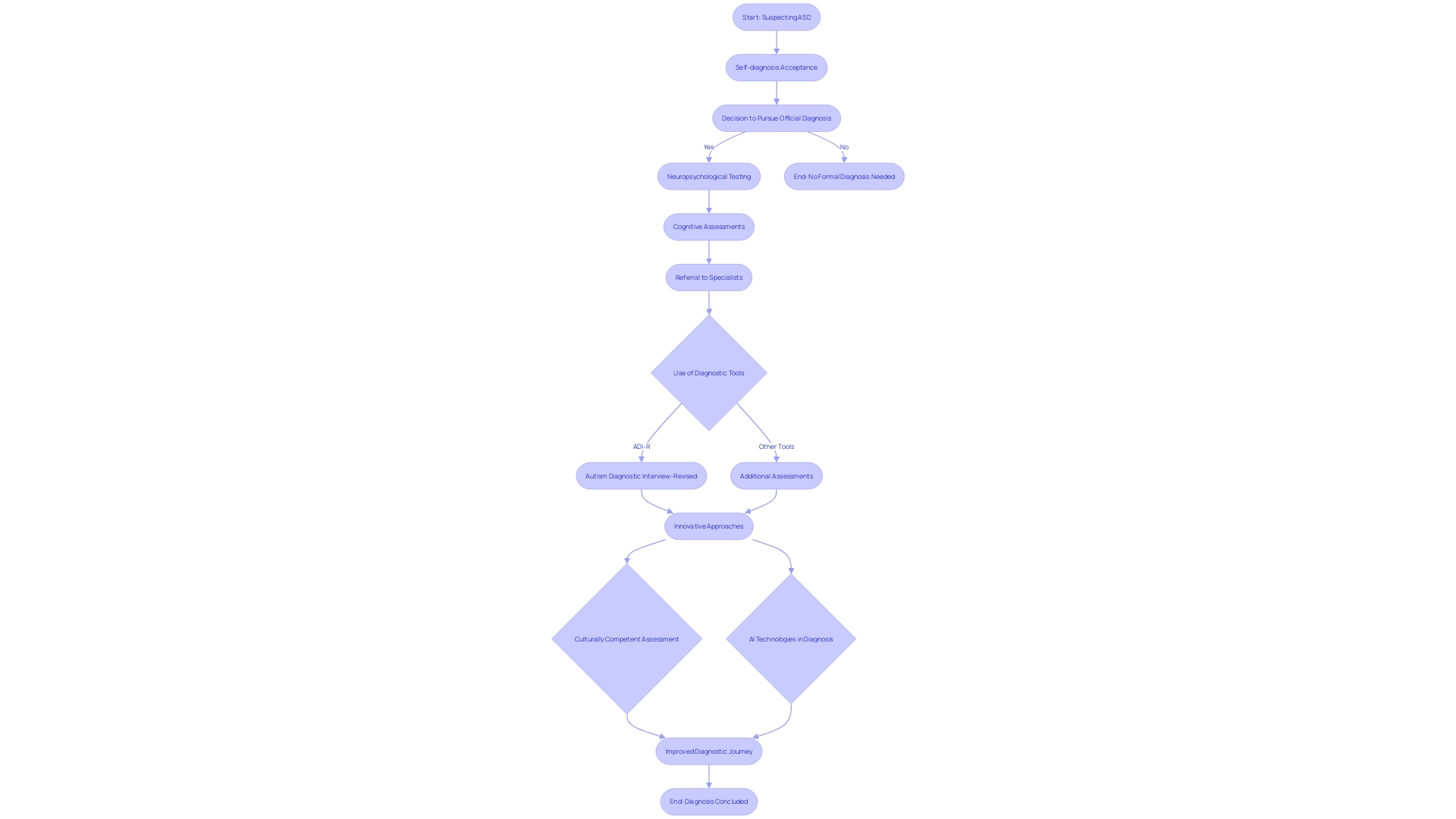
Hearing and Vision Screening
Comprehending the complexities of autism spectrum disorder (ASD) necessitates a thoughtful approach to assessment, which incorporates hearing and vision screening as vital components. The auditory and visual systems are foundational to a child's development; they are the channels through which a child perceives and makes sense of the world. Any impairment in these senses can significantly affect communication and behavior, which are core areas evaluated in ASD diagnoses.
Historically, pioneers like Sir Alexander and Lady Ethel Ewing stressed the significance of timely detection of hearing loss, advocating for the screening of newborns to ensure prompt educational interventions. This concept has evolved into modern newborn hearing screening programs that utilize objective electrophysiological assessments to identify potential hearing impairment as soon as possible.
It is well-documented that individuals with typical hearing start acquiring speech and language skills immediately after birth. By six months, they can discern the basic sounds of their language. This swift developmental trajectory underscores the significance of hearing detection. For example, in the United States, two to three out of every 1,000 individuals are born with detectable hearing loss in one or both ears. The Early Hearing Detection and Intervention (EDHI) Act has ensured that newborns are screened for hearing loss before they leave the hospital, enabling families to seek early support if necessary.
An audiogram is a valuable tool in hearing assessment, providing a detailed representation of the individual's hearing capabilities. This assessment helps clarify the type and degree of hearing loss—be it mild, moderate, severe, or profound—and whether it is conductive, often treatable, or sensorineural, which is permanent but manageable with hearing devices. Identifying whether the loss is unilateral or bilateral, and determining the underlying cause, are also critical steps in creating an effective intervention strategy.
Similarly, vision screening has made significant strides, with studies exploring the use of retinal imaging and artificial intelligence to potentially diagnose ASD and assess its severity. For instance, AI has been employed by Korean scientists to examine retinal images in youngsters, assisting in distinguishing those with and without an ASD identification.
The importance of thorough sensory screening is further underscored by statistics revealing that individuals with ASD are more likely to experience co-occurring physical and mental health conditions, affecting their overall health and longevity. These findings make it clear that a comprehensive diagnostic approach, including hearing and vision screening, is not just beneficial but essential for individuals undergoing autism testing.
Overall, hearing and vision screenings are not merely routine examinations; they serve as an entryway to comprehending a young individual's sensory realm, which can hold significant implications for the identification and assistance of ASD. By integrating these screenings into the evaluation process, healthcare professionals can provide a more nuanced understanding of every individual's distinct requirements, resulting in customized interventions that can greatly improve their quality of life.
Interpreting Results and Making a Diagnosis
The crucial role of expert analysis in identifying individuals with autism cannot be emphasized enough. It involves not only examining the individual's behavior and developmental history as reported by parents or caregivers, but also aligning these observations with standardized criteria such as those outlined in the DSM-5. The complexity of autism, with its wide range of behaviors and the variability in how it presents itself, requires a nuanced approach to identification. A thorough assessment may involve the knowledge of neurodevelopmental pediatricians, neurologists specializing in pediatric care, or geneticists, among others. Recent advancements in diagnostic tools, like the Sense to know application, leverage artificial intelligence and machine learning to assess behaviors such as eye movement, facial expressions, and motor skills. This technology improves the accuracy of the assessment, potentially reducing the diagnostic process for families. With the prevalence of autism reaching as high as 1 in 36 individuals, according to the CDC, it is crucial to have accurate and early identification, as it paves the way for early intervention and optimal results for children on the spectrum.
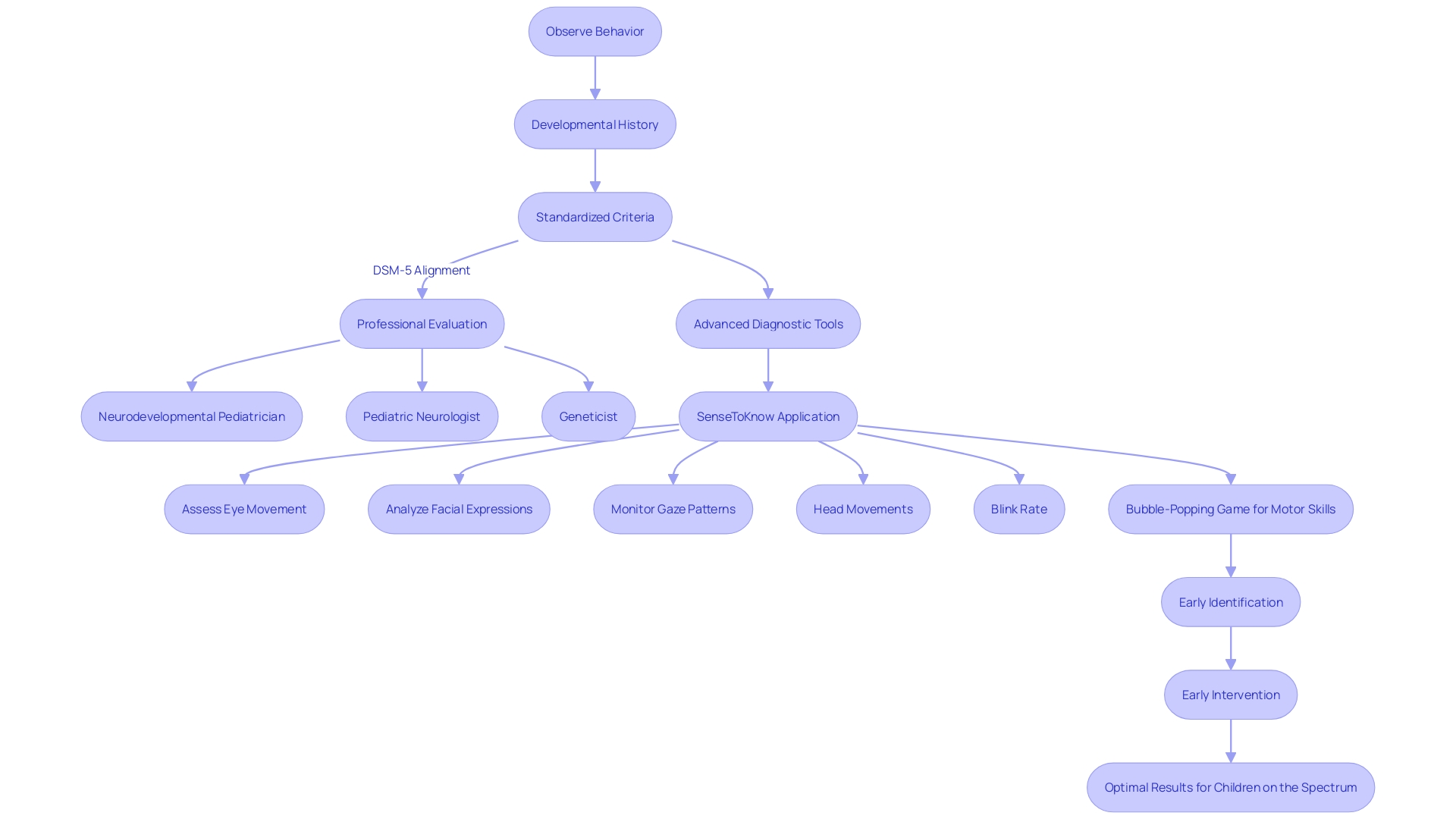
Developing a Treatment Plan and Recommendations
A detailed and customized treatment plan is crucial after identifying a condition, acting as a flexible roadmap that delineates a patient's mental health condition and the intended direction. The plan typically encapsulates the initial assessment and diagnosis, sets forth specific treatment goals and objectives, and details the therapeutic interventions and strategies to be employed. It also includes a projected timeline for the treatment journey, though flexibility is integral, as the plan should evolve in concert with the patient's progress and changing needs. This strategy ensures a consistent approach to therapy, offering a structured yet adaptable framework for clinicians to follow and adapt, ultimately aiming for tangible improvements in the patient's life, such as symptom reduction or enhanced daily coping mechanisms.
The neurodiversity movement, which recognizes autism as a natural variation in the human brain rather than a disorder that requires curing, further emphasizes the importance of person-centered care. This approach acknowledges the unique challenges faced by autistic individuals while advocating for supportive environments tailored to their needs. Moreover, initiatives like the Kevin and Avonte Program demonstrate the practical implications of specialized support strategies, addressing specific behaviors like wandering and offering resources to assist individuals and their families.
Collaborating with parents is also pivotal in treatment planning. Clear, empathetic communication and active listening establish a solid rapport, fostering a cooperative relationship that prioritizes the young one's well-being. In this partnership, the parents' insights and concerns are valued, creating a supportive network that empowers them to contribute effectively to their child's developmental journey.
The importance of accurate and timely diagnosis is emphasized by organizations like The Autism Community in Action (TACA) and Neurocare. Research highlights the advantages of initiating treatments like behavioral therapy at a young age, which can greatly improve outcomes. With the introduction of new technologies, the objective is to minimize the frequently extensive and upsetting diagnostic procedure, aiming to identify the condition on the spectrum as early as feasible. This proactive stance is especially crucial for families with a higher risk of developmental disorder, where early detection can make a profound difference.
In brief, the development and continuous improvement of a treatment plan are crucial stages in the path towards managing individuals with ASD. It provides a framework for both families and professionals to navigate the complexities of autism care, ensuring that every therapeutic intervention is aligned with the individual's goals, fosters their strengths, and addresses their challenges in a holistic and empathetic manner.
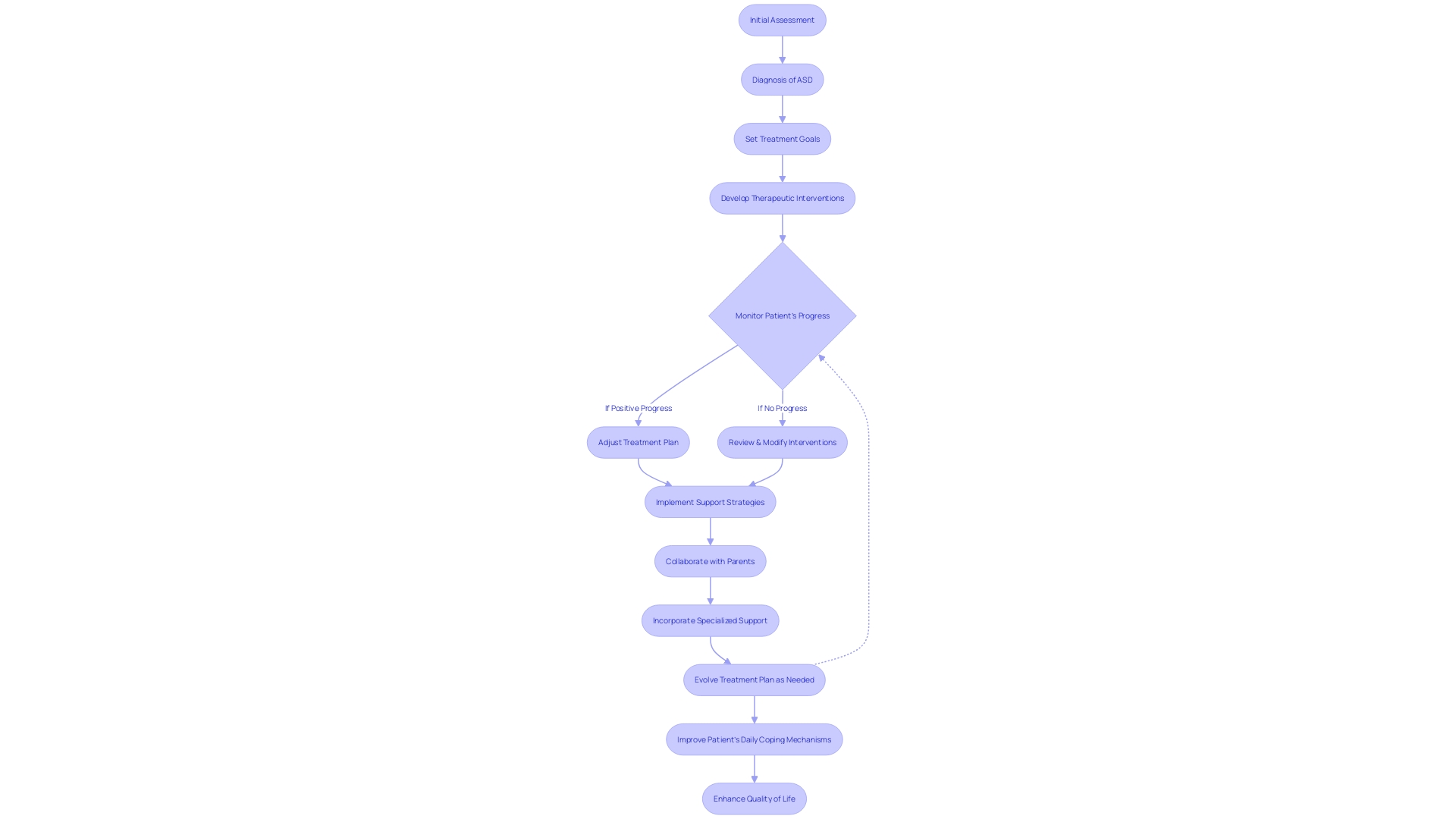
Conclusion
Understanding autism spectrum disorder (ASD) is crucial for supporting affected children. Early detection and accurate diagnosis play a vital role in shaping their future. Technology, such as eye-tracking and machine learning, offers hope for more precise diagnoses.
ASD diagnosis involves discussions with healthcare professionals, standardized tools like ADOS-2 and ADI-R, and innovative approaches like SenseToKnow. Direct observation, interviews with caregivers, and assessing co-occurring conditions are essential. Hearing and vision screenings are critical, as impairments in these senses can significantly affect communication and behavior.
Interpreting results and developing a tailored treatment plan are crucial steps following an autism diagnosis. The goal is to provide early intervention and the best possible outcomes for children on the spectrum. A comprehensive evaluation process, including standardized assessments and insights from parents and caregivers, is crucial.
Collaboration among federal agencies and advocacy groups enhances coordination and communication. Standardized assessment tools like ADOS-2 and ADI-R play a pivotal role in autism diagnosis, while innovative approaches leverage technology. Direct observation adds a critical dimension to the diagnosis, supporting targeted interventions.
Understanding the unique experiences of parents and caregivers is essential, and community involvement and support are impactful. Addressing co-occurring conditions is crucial for a comprehensive understanding of each child's needs. Neuropsychological testing and cognitive assessments provide a comprehensive view of a child's capabilities.
Hearing and vision screenings are vital elements in the diagnostic process. Expert analysis and interpretation of results are pivotal, and early intervention is crucial for optimal outcomes. Developing a tailored treatment plan in collaboration with parents and caregivers is essential.
By embracing a comprehensive approach, we can support children and their families on their unique journey with autism.




